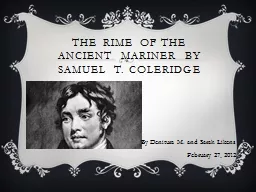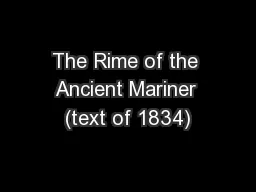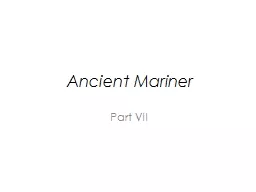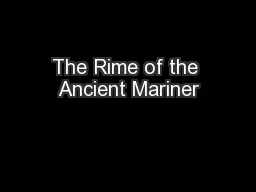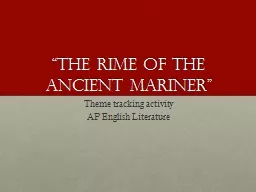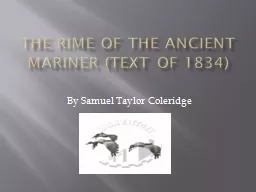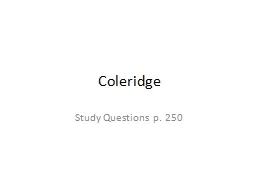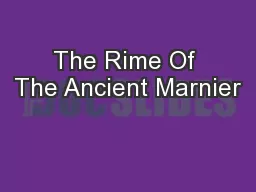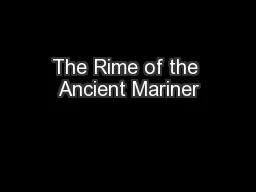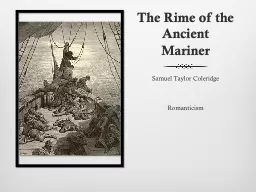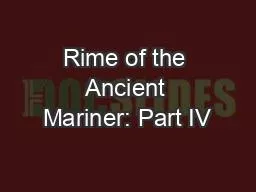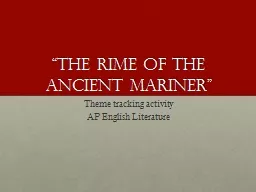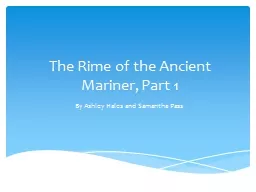PPT-The Rime of the Ancient Mariner by Samuel T. Coleridge
Author : karlyn-bohler | Published Date : 2016-05-06
By Denitura M and Sarah Likens February 27 2012 Literal Sense of the Poem The story of a mariner who is on a long voyage and runs into three men who are en route
Presentation Embed Code
Download Presentation
Download Presentation The PPT/PDF document "The Rime of the Ancient Mariner by Samue..." is the property of its rightful owner. Permission is granted to download and print the materials on this website for personal, non-commercial use only, and to display it on your personal computer provided you do not modify the materials and that you retain all copyright notices contained in the materials. By downloading content from our website, you accept the terms of this agreement.
The Rime of the Ancient Mariner by Samuel T. Coleridge: Transcript
By Denitura M and Sarah Likens February 27 2012 Literal Sense of the Poem The story of a mariner who is on a long voyage and runs into three men who are en route to a wedding He proceeds to tell him a story about the albatross that he killed and that he must continue to tell the story throughout eternity. Author biography . Coleridge was born on October 21,1772 in Ottery St. Mary, Devonshire. His father, who was the vicar of Ottery and the headmaster of its grammar school, died when he was yet a boy, in 1781. Thereafter, to continue his education, Coleridge was enrolled at Christ's Hospital in London an institution famously described in an essay by Charles Lamb. After ten years there he matriculated in Jesus College, Cambridge, where he was known for his wide reading and impressive eloquence. Financial problems, however, drove him from Cambridge, and in his third year he interrupted his education and traveled to London to enlist in the 15th Dragoons, using the pseudonym Silas Tomkyn Comberbache. His friends, recognizing how ill-suited he was for military life, were able to buy him out of this improbable misconception of his destiny and persuaded him to return to Cambridge.. By Samuel Taylor Coleridge. Argument. How a Ship having passed the Line was driven by storms to the cold Country towards the South Pole; and how from thence she made her course to the tropical Latitude of the Great Pacific Ocean; and of the strange things that befell; and in what manner the . Part VII. Carry over questions….. Why is the Hermit on the Pilot’s boat?. Why a Hermit & not a priest?. Can he absolve (shrieve) the Mariner’s sin & alleviate his burden?. First Stanza (514-518). Made by . Jaeyoung. Park. Jason Choi. Paraphrase:. Mariner can pray and sleep again. Exhausted from curse and thirst, he falls a sleep and credits his sleep to Mary Queen.. He wanted to drink water, and he dreams about drinking water. When he wakes up, it rains.. Theme tracking activity . AP English Literature . INstructions. Each group will be assigned a particular theme to “track” throughout the poem. Evidence should be located throughout the poem; do not merely focus on one part. . By Samuel Taylor Coleridge. Argument. How a Ship having passed the Line was driven by storms to the cold Country towards the South Pole; and how from thence she made her course to the tropical Latitude of the Great Pacific Ocean; and of the strange things that befell; and in what manner the . Study Questions p. 250. Samuel Taylor Coleridge’s great friends and collaborators were . W. Wordsworth. and his sister . Dorothy. ; they settled in the . Lake District. and the two poets worked together on the composition of the “. Christian Coleman. Shikira. Bills. Jerrica. McDowell. Brittney Tate. Author’s Biography . Samuel Taylor Coleridge. . Born : October 21, 1772. Ottery. St. Mary, Devon, England. . Died : July 25, 1834. What is the Flying Dutchman? . Watch the clip…. How is the movie clip similar to the gambling match between Death and Life-in-Death in “Rime of the Ancient Mariner”? How is it different? Do you believe there are higher powers at war over souls in this universe? Explain. . Guided analysis. p. 257. GUIDED ANALYSIS. Answer these questions.. How can we percieve both the spiritual and physical loneliness the Mariner had to face during his trip and his joy at being again among human beings.. Samuel Taylor Coleridge . Romanticism. Background. Originally published in 1798 as The Rime of the . Ancyent. . Marinere. .. the language . went against the emerging Romantic tradition of writing in contemporary, unrhymed language . Andrew Perricone • Imogen Rosenbluth. Kalev Rudolph • Alyssa Stump. Stanzas 1 & 2. 'I fear. thee, ancient Mariner!. I fear . thy . skinny hand. !. And thou art . l. ong,. . l. ank, and brown,. Theme tracking activity . AP English Literature . INstructions. Each group will be assigned a particular theme to “track” throughout the poem. Evidence should be located throughout the poem; do not merely focus on one part. . By Ashley Hales and Samantha Pass. Samuel . Taylor Coleridge: October 21, 1772 -July 25, . 1834. He studied at Jesus College where he met lifelong friend Robert . Southley. , who influenced a lot of his work. .
Download Document
Here is the link to download the presentation.
"The Rime of the Ancient Mariner by Samuel T. Coleridge"The content belongs to its owner. You may download and print it for personal use, without modification, and keep all copyright notices. By downloading, you agree to these terms.
Related Documents

